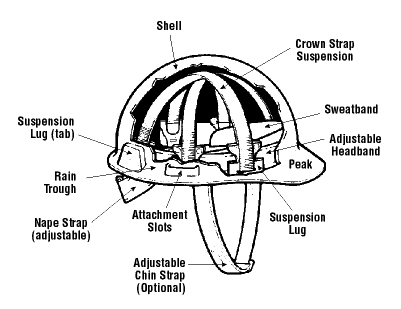Headwear, Care of
On this page
What should I know about head protection?
Back to topIf you are at risk for head injury at your workplace, you should wear the appropriate head protection against impact and small flying or falling objects.
- If head protection is required, establish a complete safety protection program including selection, fit testing, training, maintenance and inspection.
- Choose the correct headwear for the job. Refer to CSA Standard Z94.1-15 "Industrial protective headwear - Performance, selection, care, and use" or the legislation that applies in your jurisdiction.
- Classes of headwear can include:
- Type 1 - protection from impact and penetration at the crown (top) only
- Type 2 - protection from impact, penetration at the crown (top) and laterally (sides and back)
- Each type is also available in the following classes:
- Class E (20 000 V electrical rating) - provides head protection against high voltage conductors
- Class G (2200 V electrical rating) - provides head protection against low voltage conductors (general trades)
- Class C (no electrical rating)

- Headwear consists of a shell and the suspension. These parts work together as a system and both need regular inspection and maintenance.
- Do not transport headwear in rear windows of vehicles. Heat and UV light (including sunlight) can damage the material, making it brittle and less protective.
- Inspect headwear before each use.
- Always check with the manufacturer when adding or using accessories (non-metallic stickers, tape, bandanas, handkerchiefs, welder's cap, etc.).
- Inspect winter liners to ensure they do not interfere with fit of headwear.
- Do not draw the chin strap over the brim or peak of the headwear.
- Do not wear baseball style hats under the headwear as it interferes with the suspension.
- Only wear the hard hat with the peak at the back, if the suspension has been adjusted so the nape strap remains at the back of the head. Check with the manufacturer to ensure the headwear was designed to be worn this way.
- If high visibility headwear is required, consult with CSA Standard Z96 High-visibility safety apparel for colour and retroreflective performance specifications.
- Insect repellant or other chemicals can degrade the headwear material. Ask the manufacturer if the products are compatible.
Note: Certain CSA Group standards are available for online viewing. To access these, you must first create an account with “CSA Communities”.
Go to: https://community.csagroup.org/login.jspa?referer=%252Findex.jspa
Once you are logged in, click on the text below the “OHS Standards / View Access” graphic.
Click on the jurisdiction of your choice to see the CSA Standards as referenced in that legislation. Standards may also be purchased from CSA Group: https://store.csagroup.org/
What should I know about the shell of my headwear?
Back to topThe shell is rigid and light, and is shaped to deflect falling objects. Correct maintenance is important.
DO:
- Inspect and replace a shell that shows signs of wear, scratches or gouges. Shells exposed to heat, sunlight and chemicals can become stiff or brittle. A visible pattern of tiny cracks may develop. Over time, weathered hats can become dull in colour or have a chalky appearance.
- Replace headwear when any of the above signs of wear start to appear.
- Replace headwear that has been struck, even if no damage is visible.
- Remove and destroy any headwear if its protective abilities are in doubt.
DO NOT:
- Do not drill holes, alter or modify the shell. Alterations can severely affect the protection provided by the headwear.
- Do not paint the plastic shell. Paint solvents can make plastic headwear brittle and more susceptible to cracks. Paint can also hide cracks that may develop. Instead, use reflective marking tape to make numbers or symbols for identification purposes. Some headwear may be painted, but check with the manufacturer for approval.
- Do not use winter liners that contain metal or electrically conductive material under Class G or E headwear.
- Do not use metal labels on Class G or E headwear.
What should I know about the suspension of my headwear?
Back to topThe suspension system is as important as the shell. It holds the shell away from the head and acts as a shock-absorber. It also holds the shell in place on the head and allows air to flow freely.
- Adjust headband size so that headwear will stay on when the wearer is bending over, but not so tight that it leaves a mark on the forehead.
- Ensure that the suspension is in good condition. The main purpose of the suspension is to absorb energy.
- Look closely for cracked or torn adjustment slots, frayed material or other signs of wear such as dents, cuts, or gouges.
- Check the suspension lugs (tabs) carefully. Long periods of normal use can damage the suspension. Perspiration, hair oils, dirt, insecticides, hair sprays and hair treatments can speed up the deterioration of suspension materials.
- Replace the suspension if it has torn or broken threads.
- Only use liners if approved by manufacturer.
- Do not put anything between the suspension and the shell. There must be a clearance inside the headwear while it is being worn. In case of a blow to the head, that space helps absorb the shock.
- Do not use a suspension made by one manufacturer with products made by another manufacturer.
- Do not change or alter any of the suspension, liner or shell.
What should I know about maintenance?
Back to topThe care and maintenance of headwear are needed if the headwear is to protect as designed. Its lifespan is affected by normal use and by heat, cold, chemicals and ultraviolet rays.
- Clean the suspension and shell regularly with mild soap and warm water and/or according to the manufacturers' instructions.
- Fact sheet last revised: 2020-10-22

